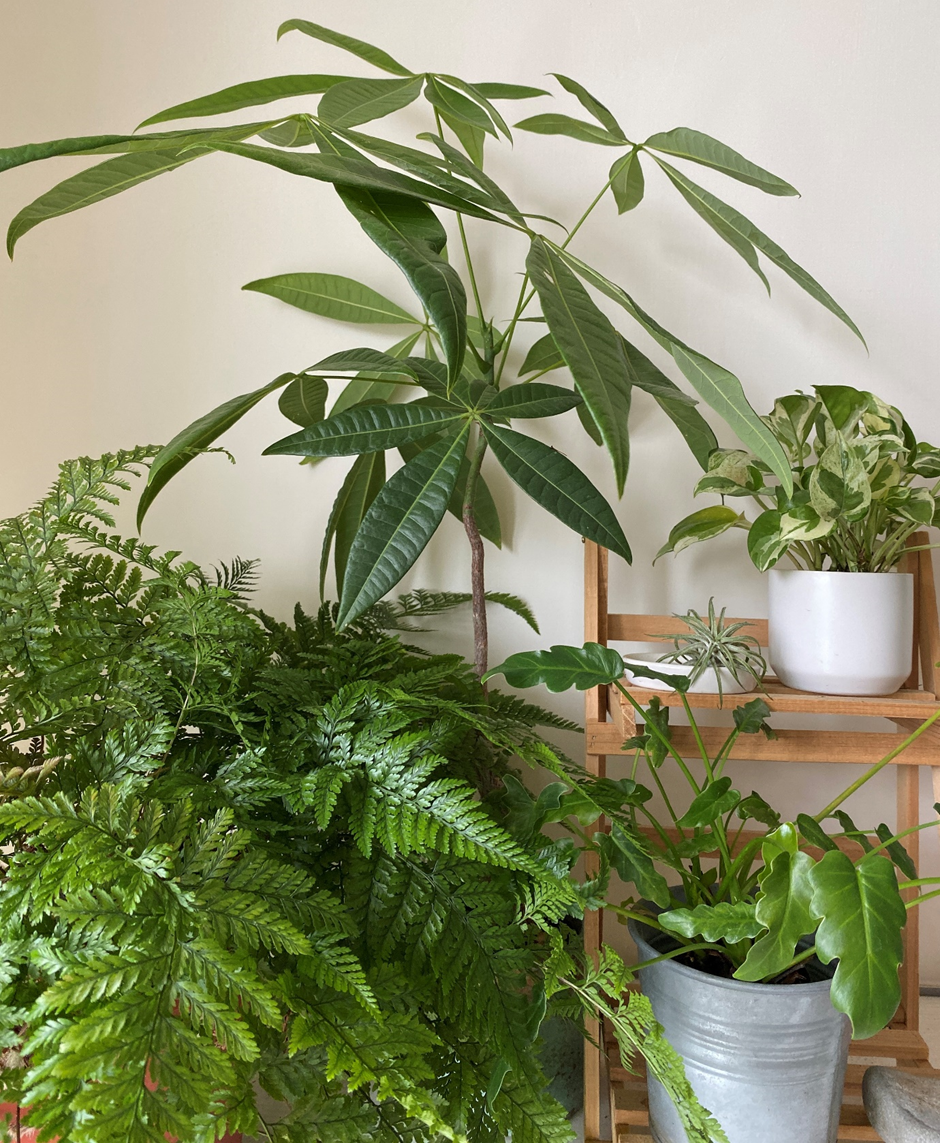Table of Contents
The Schefflera or ‘Umbrella plant’ is an excellent option if you want an easy-to-grow variety for your workspace, living, or bedroom. This indoor plant grows fast and adds greenery in closed spaces.
Schefflera is a tropical plant and ideal for anyone who gardens, regardless of experience level. The Umbrella plant is a lush green plant species that grow in different varieties, sizes, and shapes. The most low-maintenance and beautiful plant types are Schefflera ‘actinophylla,’ Schefflera ‘arboricola,’ Schefflera ‘digitata,’ and Schefflera ‘elegantissima.’
The blog will go through every detail, including its growing requirements like watering and fertilisation schedule. Additionally, you will learn about the caring methods of the umbrella plant and how and when to prune, propagate, and transplant.
Continue reading to learn more Schefflera details!
Schefflera ‘Umbrella Plant’ Overview
| Family | Araliaceae (Ginseng) |
| Genus | Schefflera |
| Scientific name | Schefflera arboricola |
| Type | Evergreen bush/tree |
| Sobriquet | Umbrella plant/Parasol plant |
| Other names | Schefflera Arboricola, Dwarf Umbrella Tree, or Octopus tree |
| Place of origin | Australia, New Zealand to south-west Pacific, Taiwan &China |
| Height | 1-3 feet (indoors) |
| UK hardiness | H1b |
| USDA hardiness | 10-12 |
| Bloom time |
|
Growing Schefflera Plant
Schefflera ‘Umbrella plant’ is a tropical evergreen bush or tree and is native to the temperate regions of the globe. It is a member of the Araliaceae family. It is typically grown as a houseplant in the UK.
The plant forms leathery leaves that sprout in a ray-like formation from the leaf stalks, giving it a decorative appearance. The Schefflera foliage offers shelter, which has inspired its common name, the umbrella plant or the parasol plant.
The plant withstands inadequate sunlight. Thus it enjoys popularity as an excellent plant for indoor gardening.
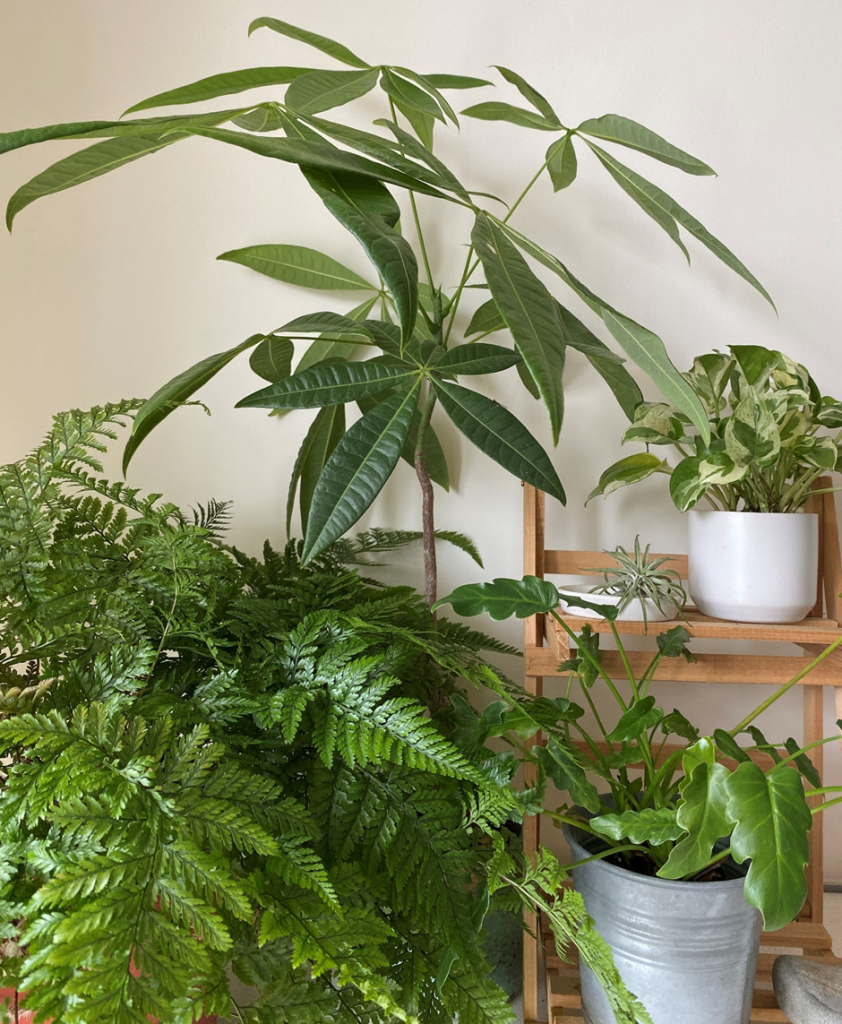
1. Soil and Watering Needs
- Schefflera plant prefers nutritionally rich soil. It grows well in properly drained potting soil if you are growing it in interior spaces. However, it needs sandy, loamy soil containing a pH rating between 6.0 and 7.5 for garden cultivation.
- It indicates that soil needs to be moderately acidic. The plant cannot withstand waterlogged or excessively wet soil.
- The green foliage may fall away, and fresh shoots may become black due to overwatering. During winter months, Schefflera remains dormant. It does not need feeding.
- The plant prefers indirect sunlight but also tolerates low-light conditions. It needs frequent hydration, fertilisation, and warmth during its growing season in the spring and summer seasons.
2. Fertilisation Process of Umbrella Plant
Schefflera is an indoor plant and does not get nutrients from nature. Thus, it requires regular and additional feeding. In this section, you come to know the feeding essentials in detail.
- Fertilise your Schefflera tree every one to two months from spring to autumn, introducing a well-balanced liquid feed containing nitrogen, phosphorous, and potassium in the same proportion of 20:20:20.
- The plant heavily relies on nutrients and needs feeding at the right time for healthy growth.
- Well-developed Schefflera plants need fertilisation annually. Use water-soluble feed or compost. If the soil is less acidic, you may add coffee grounds to enhance the soil’s properties.
- Watering the plant is advised before fertilising it. Avoid over-fertilising the plant because it will harm it beyond what under-fertilization will do.
- If your Schefflera has received excessive fertilisation, take some quick action. At first, stop feeding, scratch the topsoil from the affected area, or dissolve the extra fertiliser.
- In severe circumstances, you might change the over-fertilised soil with brand-new soil. Wait about two months after repotting before starting fertilisation.
- Product 1: Gives up to two weeks protection
- Product 1: A residual contact insecticide
- Product 1: Fast acting control of insects including whitefly greenfly blackfly and many more
Caring for Schefflera ‘Umbrella Plant’
You should follow an appropriate caring routine for your ‘Umbrella plant.’ They are pruning, pest and disease prevention, repotting, and propagation. Pruning is vital for the plant’s health and appearance. The best time for Schefflera- pruning is spring. Read on to understand the caring procedures.
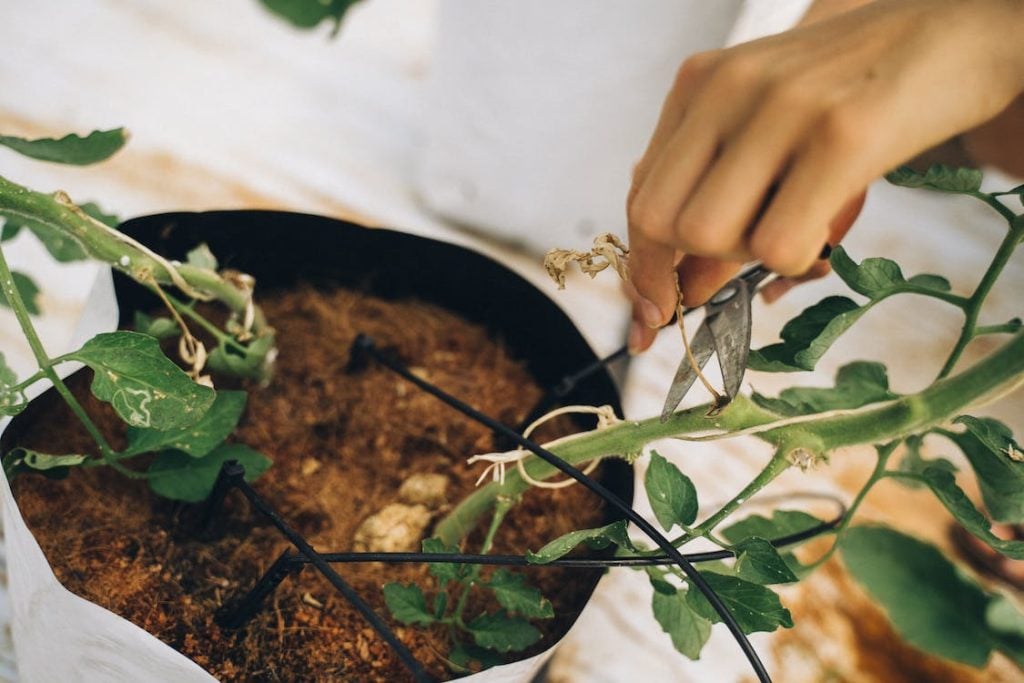
1. Scheduling the Schefflera Pruning
Consider your plant’s desired appearance before pruning. Search for the leaves or stems that need your pruning service.
Unsurprisingly, umbrella plants with multiple stems appear bushy, whereas those with a single one appear more like trees. Hence, carefully choose the best option that will enhance the value of your home or garden space.
Take a sharp and sterilized pruner. Cut right above the leaves and trim the top of the tallest stems to encourage healthy growth.
2. Ideal Pruning Season
Prune your Schefflera plant only in the growing season, which will help the plant push out more growth.
However, damaged stems or leaves can be pruned at any period. If you locate long, unhealthy-looking stalks, bring them down to 3-4 inches. The indoor plant will look thicker and neater.
If your Schefflera plant has become too dense, you can prune it to break up thicker foliage. Make cuts to break up thick foliage and keep leaves only at the ends.
3. Pest and Disease Prevention
Although the parasol plant is resilient and withstands pests and diseases to some extent, several pests and diseases can ruin its growth and ultimately destroy the plant. Here are some tips for safeguarding your beautiful plant
Here are some common pests and diseases that can affect Schefflera plants:
Common Pests
You should know about Mealybugs, Scale insects, Mites, Aphids, Caterpillars, and Fungus gnats, enemies of your Umbrella plant.
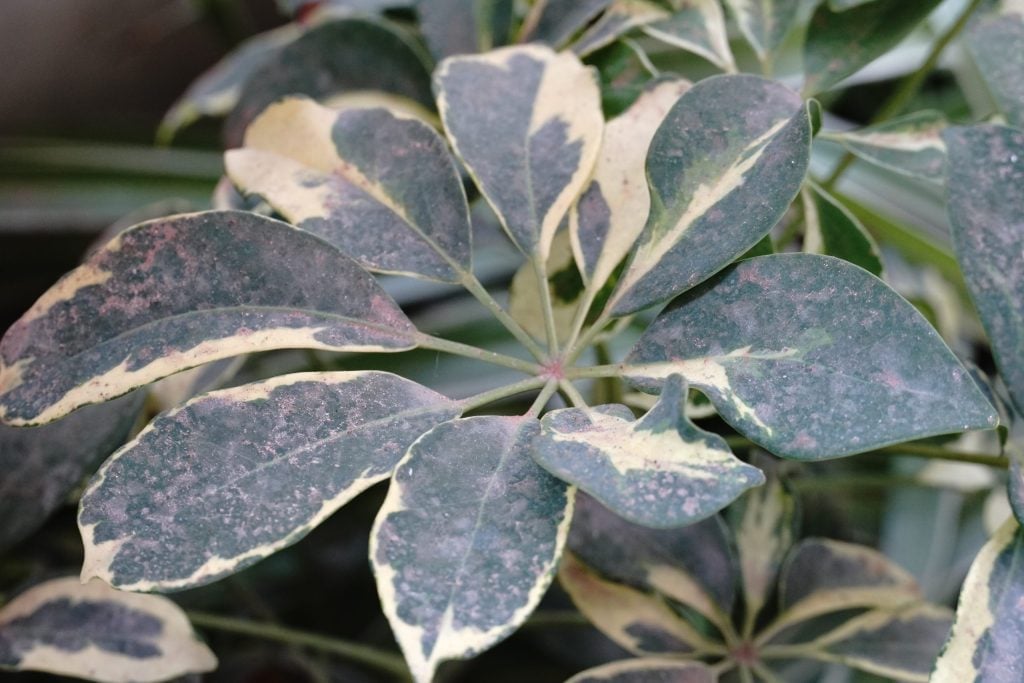
- Mealybugs are minute, whitish, waxy pests that drink the plant sap with their mouth duct. They produce a sticky fluid that draws ants.
- Fungus gnats are dark brown flies that are difficult to identify due to their colour, but can be caught by shaking the plant. The gnat larvae enter the soil and damage the Schefflera’s root by puncturing it.
- When your plant suffers from inadequate moisture, Spider mites can weaken the Umbrella plant’s leaves by sucking the juice of it. They weave webs around the plant, causing the leaves to shed.
- Aphids strike when your plant is over-irrigated and placed in a dull corner of the room. They feed on the leaf and stem juices, casing the yellowing and curled leaves.
- Scales prevent plants from growing and make them wilt because they are rigid and tough to remove. On the plant’s leaves, they are frequently misidentified for small lumps or inconsistent growth. Caterpillars make holes in the leaves.
Common Diseases
Bacterial or fungal infections can badly damage the Schefflera tree. It’s critical to uphold the perfect conditions for growth, including appropriate feeding, water supply, and drainage, to avert infections caused by bacteria and fungi in Schefflera plants.
Here are some common bacterial and fungal infections that can affect Schefflera plants.
| Bacterial leaf spot | This bacterial disease produces water-soaked, tiny marks on the leaves that eventually turn brown and fall off. It is caused by the ‘Xanthomonas campestris’ bacteria and can be prevented by maintaining dry foliage and avoiding over-fertilization |
| Fungal leaf spot | This fungal disease causes circular, brown spots on the leaves that may have a yellow halo around them. Other fungus infections affect the roots of young seedlings and cause them to rot and die. |
| Root rot | This fungal disease affects the roots of mature plants and causes them to rot and die. It is caused by overwatering and can be prevented by allowing the soil to dry out between waterings and using well-draining potting soil. |
Prevention Methods
- When indoors, change the potted plant’s position to a bright spot, and avoid direct sun. If you keep it continuously in a dark indoor area, it becomes vulnerable to pests.
- If you notice any trace of infestation, segregate the plant from other healthy plants to stop the pests from affecting others. You can trim the pest-infected plant part to prevent these bugs from spreading.
- Provide the plant with proper conditions to remain healthy and pest free. Hence, avoid overwatering, underwatering, and extreme wetness.
- Use gloves during pruning since the tree’s sap contains calcium oxalate particles that can cause skin irritation. If bugs are few, simply pick them out.
- Rubbing alcohol is an organic pesticide. Apply it to your plant. The solution must have three water and rubbing alcohol on a 3:1 ratio. Moreover, you may use pyrethrum powder and insecticidal soaps.
- Use a fungicide approved for use on Schefflera plants for treating fungal infections.
- When the topsoil gets dry, only then hydrate the soil, don’t leave it in stagnant water.
Repotting Technique
Repotting make the Schefflera plants stronger and replenish the soil. Continue to know more.
- To transplant a Schefflera ‘Umbrella Plant,’ choose a pot one size larger than the current spot. The plants should be transplanted when it becomes rootbound. This is usually evidenced by roots poking out of the drainage holes.
- Take the plant out of its current pot by holding the top of the root nodule towards you.
- Keep the root nodule’s crown part nearly an inch away from the pot’s edge while repotting the plant in another vessel. After adding more potting soil to the pot thoroughly, water the plant.
- While transplanting Schefflera plants, apply the ideal potting mix. It should be rich in organic matter and contain a pH value between 5.5 and 6.5. Peat moss, compost, and perlite can be combined to create a potting mixture, a suitable potting mix for Schefflera plants.
- The other option is to pick up a water-smart commercial garden mix that doesn’t comprise bio matter or bark since they may cause the formation of fungus. Young plants typically need to be replanted annually.
Schefflera Plant Propagation
Stem-cutting or an air layering propagation is suitable for growing the young Schefflera plant. These are seedless processes. The idle temperature during propagation must be between 15-20∘C with adequate humidity.
1. Propagation by Cutting
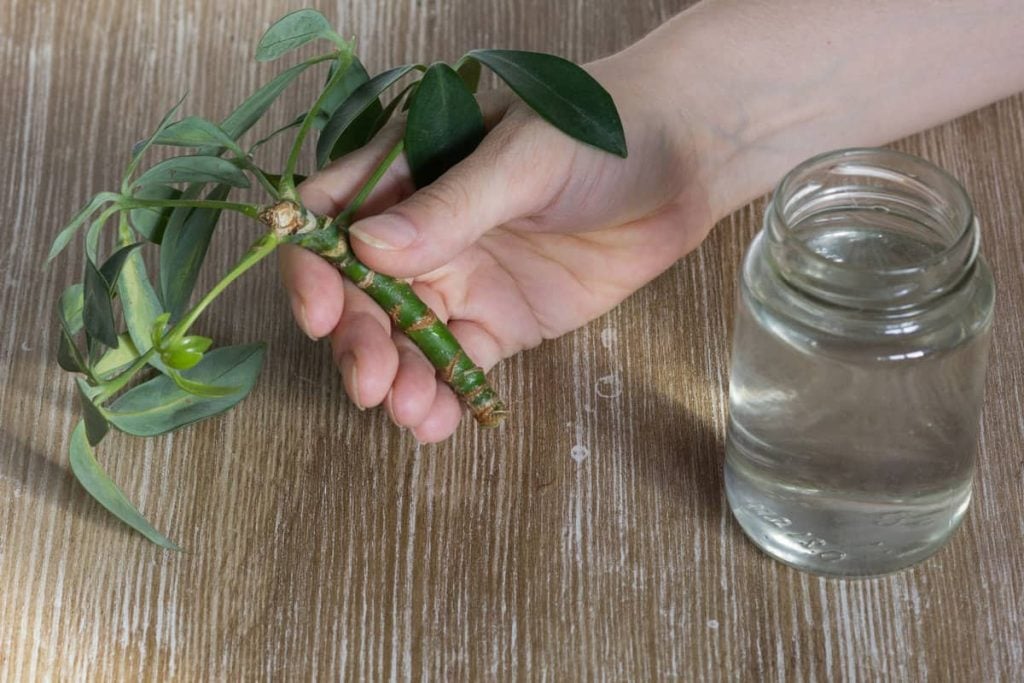
- This method follows two types of propagation techniques terminal cuttings and stem cuttings. Here is the step-by-step process of growing a new plant.
- Collect stem from the main shoot of a healthy Umbrella plant. For the terminal cutting propagation, take 10 cm. of stem below the leaf node, containing three to five leaves in the upper part of the cutting.
- Dip the cutting in potting soil ideal for propagation. Soil needs to be moist, loose, and peat-free for the well-developed root.
- On the other hand, choose the leafless lower part of the cutting for stem-cutting propagation. Remove all the leaves from the cut stem, if any.
- The cutting should be divided into parts. Each part consists of an idle bud. Place the stem cuts horizontally in the wet compost and position the idle-bud section upwards. Later, you will find young leaves emerging from them. The roots will start to show at the bottom.
These methods are suitable for any time of the year.
2. Air Layering Propagation
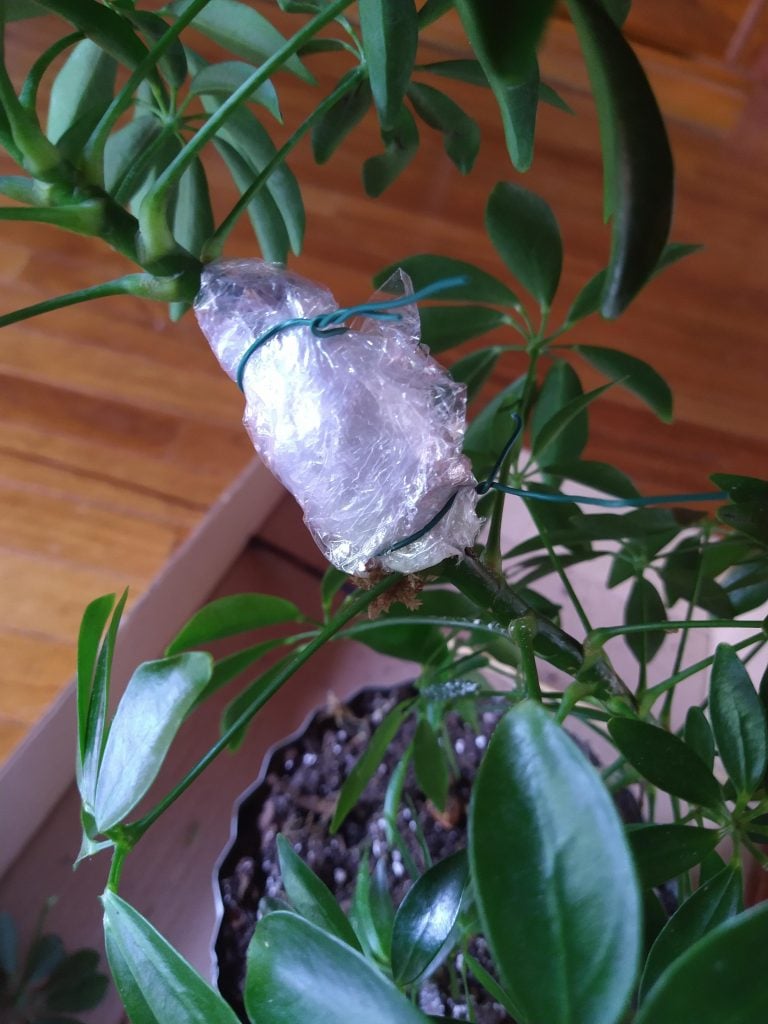
- Air layering propagation is ideally done during autumn or spring.
- Select a mature Umbrella plant for stem-cutting for the air layering propagation.
- Make a flat flap by cutting the plant’s stem from the base side up. Stop slicing just below an idle bud or leaf. Put a tiny boulder or some wet moss inside it to prevent sticking.
- Cover the cutting with damp pat moss. Now cover it with food plastic wrap tightly to retain moistness. After two weeks, open it to see root development, and moist the cuttings if required.
- The young plant should be separated from the parent plant and placed in a separate pot after the roots have grown.
Conclusion
We believe that this article has shed some light on how to take care of your Schefflera umbrella plant. Although the plant in question is an eye-catching addition to any indoor space or landscape, it does take a little elbow grease to keep it looking good and healthy. The best way to ensure they always look their best is by taking good care of them.
I hope in this article, you have learned about the umbrella plant’s growing needs. You should remember that this home-loving plant requires slightly acidic soil. It needs more feeding during its growing period. Repotting is vital for its health. Follow the suggestions we offered you to keep your plant away from bugs and infections.
Share your experience of growing Schefflera plants with us in the comment section below.

